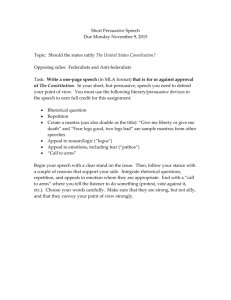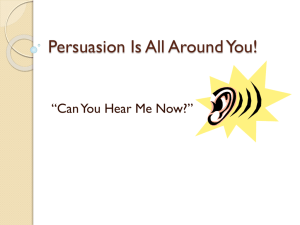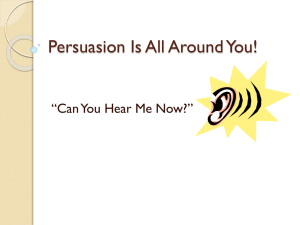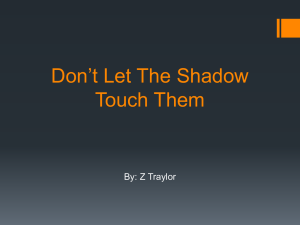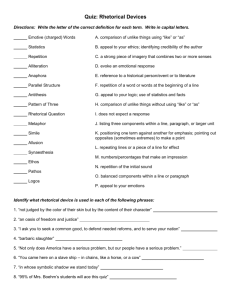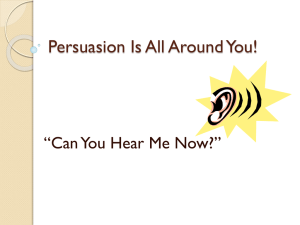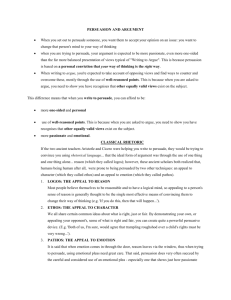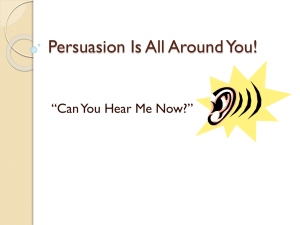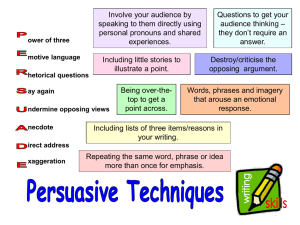Rhetorical Devices and Persuasive Devices
advertisement
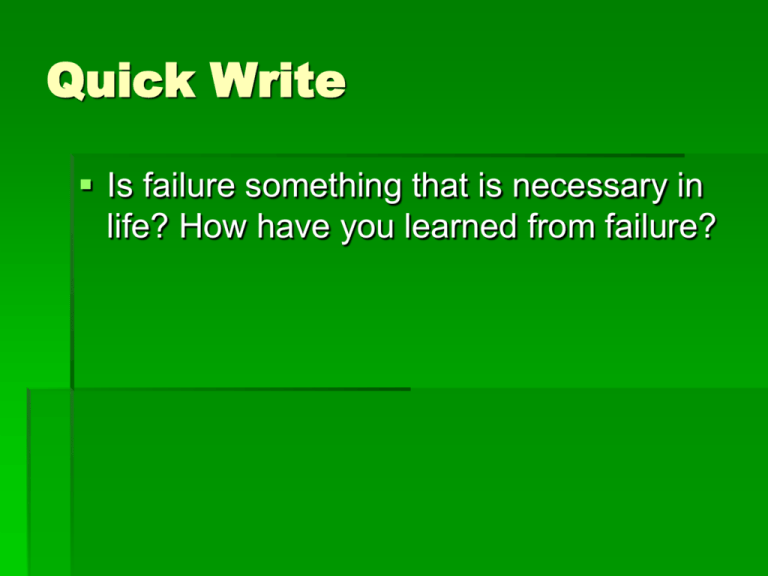
Quick Write Is failure something that is necessary in life? How have you learned from failure? English 11 Honors Taking a Stand Persuasive Vocabulary Unit Objectives To identify persuasive techniques in informational texts and our world Summative Assessment A group project that looks at persuasion in the world today. You will have an individual component in the project. Your research will be presented to the class. We will look at the Revolutionary time period and how persuasion was used at the start of our country. Persuasion: a type of speaking or writing that is intended to make its audience adopt a certain opinion, perform a certain action, or do both. RHETORICAL DEVICES Pathos – an appeal to the audience’s emotions. Sometimes we come to believe something or to act upon something just because of a gut feeling or an appeal to our emotions. For example, we may act out of fear, greed, love and compassion. Logos – an appeal to the audience’s sense of logic. Sometimes it just seems logical to believe or do something because the speaker or writer offers facts, quotations and/or statistics from reliable experts. Ethos an appeal based on someone’s credibility. Sometimes we believe something simply because someone we trust tells us it is true or act upon something because that person says we should. PERSUASIVE TECHNIQUES Charged Words Charged words are words with strong connotations beyond their literal meaning that are likely to produce an emotional response. Tyranny (evokes a feeling of fear, suggests living in a state of terror) Liberty (suggests an ideal life characterized by freedom) Justice (can be associated with freedom and equality) Honor (evokes a sense of morality and dignity) From Donald Trump’s position paper on Immigration Reform: “When politicians talk about ‘immigration reform’ they mean: amnesty, cheap labor and open borders. The Schumer-Rubio immigration bill was nothing more than a giveaway to the corporate patrons who run both parties.” Rhetorical question Rhetorical question/questions are the questions the speaker asks the audience. However, the audience internalizes the answer. Nothing is answered orally. Restatement Restatement is stating the same idea in different words On Hillary Clinton’s position paper on campaign reform she is stressing the income gap. Note her word choice: Wealthy, well-connected, big money, billionaires Regular voters, everyday voters, cross-section of voters https://www.hillaryclinton.com/issues/campaignfinance-reform/ Repetition Repetition is repeating the exact same words over again. Parallelism Parallelism refers to the repeated use of phrases, clauses, or sentences that are similar in structure or meaning. Writers use this technique to emphasize important ideas, create rhythm, and make their writing more forceful and direct. From John F. Kennedy’s Inaugural Speech: Let every nation know, whether it wishes us well or ill, that we shall pay any price, bear any burden, meet any hardship, support any friend, oppose any foe to assure the survival and the success of liberty. Parallelism is verb + “any” + noun Exclamation Also used in some speeches is the use of the exclamation (or highly emotional or provocative statements) May or may not include an exclamation mark Make America Great Again! Bandwagon A fallacy based on the assumption that the opinion of the majority is always valid: everyone believes it, so you should too. This persuades us by inviting us to “jump on the bandwagon” and be part of the “in” crowd. Appeal to Authority A fallacy in which a speaker seeks to persuade, not by giving evidence but by appealing to the respect people have for the famous or highly respected. Exaggeration To represent as greater than is actually the case; overstate Call to Action Words that urge the reader or listener to take an immediate action, such as "Write Now," "Call Now," or (on Internet) "Click Here.“ Patriotism: appeals to one’s love of country over self to persuade Formative Assessment From the video at the beginning of the hour, does Marcus Zusak convince you that failure is necessary? How did he use logos, pathos and/or ethos? Do you remember?

